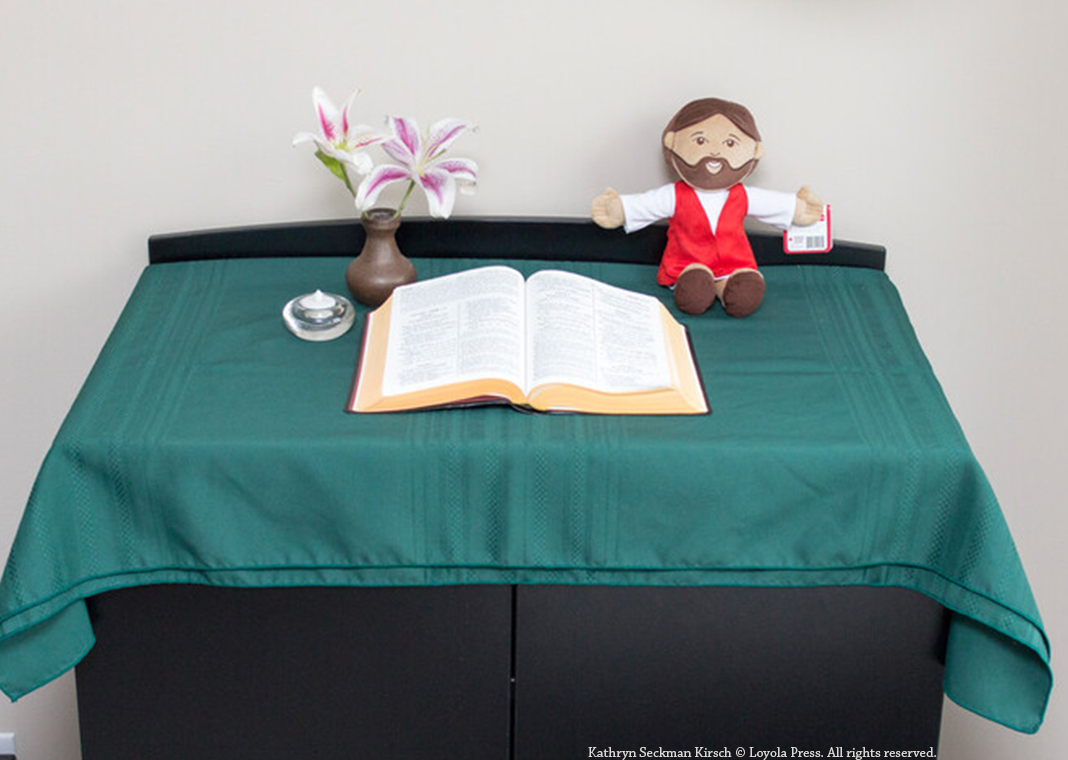
When children walk into faith formation sessions in your parish, what do they see: another classroom like they have been sitting in all day in school? Or is it an inviting space that makes it easy to form community, where matters of the heart and spirit can be shared? Does your faith formation space “speak Catholic” through sign, symbol, and a welcoming atmosphere?
When Joe Paprocki suggests in Beyond the Catechist’s Toolbox that religious education sessions should be “more like Mass than class,” he is on to something important. Faith formation is most effective when we use “the language of mystery”—verbal, physical, and symbolic—that parallels the experience of liturgy. If children see faith formation as just another academic subject, we have lost something. If we make the space prayerful and appropriate for what we are trying to accomplish, we create natural connections to the Eucharistic liturgy—the source and summit of Catholic life.
A candle and bowl of water near the entrance can link faith formation to Baptism and to the Mass and promote a sense of the sacred from the moment children arrive. It is easy to make a simple prayer table with an open Bible, crucifix, sacramental symbols, and colors of the liturgical year. Incorporating non-verbal liturgical catechesis into the space in this way provides an opportunity to discuss sacraments and seasons. Add bread and grapes or a goblet, for instance, and it’s time to talk about Eucharist.
Catechists can personalize the space, using the seasonal environment in the parish church as inspiration. Remind them this is an opportunity to be creative but reverent; objects used as liturgical symbols should appear high-quality and artful, not mass-produced and tacky. Simple is best. Prayer space should never be cluttered. If catechists need ideas, have them look at what other catechists do. The creative wisdom is in the community.
If you share a Catholic school, there should already be a prayer “focus” or table in each classroom. Even better, there may be a separate open area in the classroom—perhaps with a rug—where students can gather for prayer. Such arrangements should be available for all parish children. If working with your school to provide a shared prayer space is not possible, provide your catechists with a portable kit they can set up on a spare desk, consisting of a piece of fabric at least ample enough to cover the desk, a candle, a Bible, and a bowl for water.
If you have full control over your space, provide a prayer environment in each room—and help catechists personalize it and bring it to life by using the room to make students’ experience feel different from school. Actions such as hospitality/greeting at the door and prayer time gathered around the symbols at the start and finish of the session can allow children to sense they have been in a sacred place, enhancing the connection between being gathered and sent forth from Mass—to glorify the Lord with their lives.
How do you make your faith formation space “speak Catholic”?



Thank you Joyce for sharing your thoughts. Our DRE also stresses the importance of creating an environment for spiritual formation and an encounter with Jesus in our classrooms. I have seen the positive impact that a dedicated prayer space and table can have on the youth.
Your article got me thinking about the door to the classroom – I wanted to put something on the door that would right away convey to the students that they were entering a special faith space and community. (I teach 6th grade Salvation History) I am going to try some colorful posters using some quotes about “doors” – “If anyone hears my voice and opens the door, I will enter” (Rev 3:20); “Knock and the door will be opened to you” (Mt 7:7); “Open wide the doors to Christ” (Pope St. John Paul II).
I’m interested in how other Catechists have decorated their classrom door/doorway to create a sacred space environment?